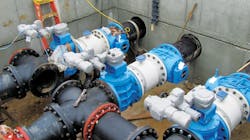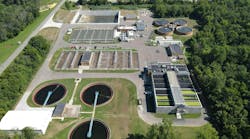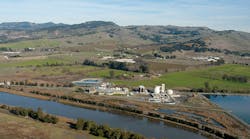Amy McIntosh is managing editor for W&WD. McIntosh can be reached at [email protected] or 847.391.1025.
- Name: Robinson Wastewater Treatment Plant
- Location: Robinson, Ill.
- Size: 6.25 mgd
- Infrastructure: Influent screening, biological nutrient removal, clarifiers, return activated sludge screening, ultraviolet disinfection, chemical metering pumps, interchange and digester tanks, mixers, submersible pumps, inclined screw press, plug valves, SCADA
With a population of less than 7,000 and a total area of less than 5 sq miles, Robinson, Ill., sits in southeastern Illinois, approximately 20 miles from the Indiana border. But what the city lacks in size, it makes up for in industry and talent, particularly at its wastewater treatment plant.
The Robinson Wastewater Treatment Plant staff installed new equipment, ultimately saving $7,000.
Necessary Upgrades
The Robinson Wastewater Treatment Plant was built in 1982. When Lawrence Quick, superintendent of public works for the city of Robinson, came onboard in 1994, the plant was near the end of its useful life. The stainless steel components were deteriorating, and a lack of proper maintenance meant the plant was in need of an overhaul.
“When I arrived in 1994, we were kind of patching holes and trying to keep things going,” Quick said. “We put in a new fine-bubble aeration system in 1996 and were able to get by with the loading until about 2007. That’s when we started planning to build a new facility.”
In 2010, the city embarked on a $7.8 million upgrade to increase the plant’s peak flow capacity from 3.75 million gal per day (mgd) to 6.25 mgd. The average flow increased from 1.5 mgd to 2.5 mgd.
The new facility features biological nutrient removal, automated storm water management, waste activated sludge screening and disposal, waste sludge conditioning, ultraviolet disinfection, effluent reuse, and a SCADA system that manages the entire plant and 12 collection system lift stations. An onsite laboratory performs process control and National Pollutant Discharge Elimination System testing.
The Robinson plant is a federally approved industrial pretreatment facility, with five significant industrial users nearby. These users include a 1,200-inmate state prison, an oil refinery, an electroplater, a hospital and a Hershey chocolate factory.
Despite the industrial flows, the influent is primarily domestic wastewater, which Quick said is not difficult to treat. However, the plant has struggled with phosphorus. Adding sodium aluminate to polish out the phosphorus has helped, but it is costly, so finding the correct balance is key.
“Sometimes we have spikes, and it’s a real challenge sometimes to feed enough of [the sodium aluminate] because it’s expensive,” Quick said. “But then again, it’s a challenge to not overfeed because of the cost. We have remained in compliance, but we have had some really close calls on phosphorus.”
Do-It-Yourself
The plant’s aerobic digestion system runs a solids yield reduction system, designed in house. Waste activated sludge is interchanged to an interchange tank, kept facultative at an oxidation reduction potential value of -400 mV. Two minutes out of every 70 minutes, approximately 3,500 gal of return activated sludge is interchanged to that tank instead of back to the biological nitrogen removal system.
“In that amount of time, it displaces that much, and that much goes back to the head of the plant,” Quick said. “We do that to create a less predominant bug, the bacteria, and when it reenters the aeration system with a more predominant aerobic bacteria, then they break it down. We do get yield reduction off of that during the warm months.”
As a cost-saving measure, plant staff often installs new equipment themselves. In 2016, staff installed a new inclined screw press.
“The employees installed that in house, so that was quite a feat,” Quick said. “We have to save money however we can, and I’ve got very capable people—especially my general foreman.”
In August 2017, plant staff retrofitted the influent screen and was able to quantify the cost savings.
“[The equipment cost] somewhere around $50,000 in parts, and the company wanted $7,000 to come install it,” Quick said. “We ended up doing it ourselves, so we saved $7,000. That was a pretty big deal.”
A nearby state prison accounts for 1,200 of the plant’s service population.


